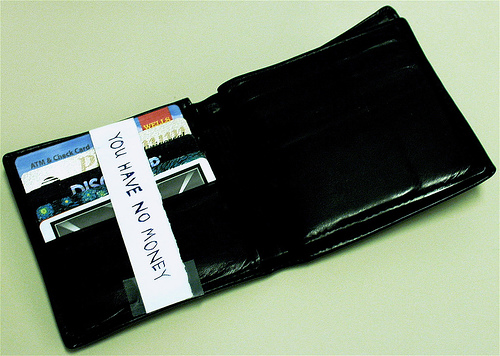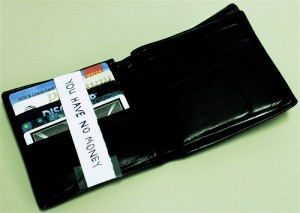What would your future-you have to say to you?
The no-pants guide to spending, saving, and thriving in the real world.
What would your future-you have to say to you?
Last week, when I mentioned that I lost my phone, there was some interest in my self-insurance warranty plan.

The truth is, that’s just one of 14 savings accounts I keep. I find it’s simpler to keep track of my savings goals by moving the money to separate accounts than to track everything in a spreadsheet. This lets me tell how I’m doing at a glance.
I have one account each at two major traditional banks. These savings accounts exist to provide a target for an automatic transfer that eliminates fees on the associated checking accounts. Whenever much money accumulates here, I sweep it out and throw it at my credit card.
I also have 12 accounts at INGDirect. I chose ING because they are extremely convenient and, at least at the time, had a competitive interest rate. Different countries have different banking options.
Here are the rest my accounts:
I also have a couple of monthly line items in Quicken that I haven’t broken into separate accounts, just to provide an overdraft buffer, like our gift budget.
That’s proof that I am over-banked. How about you? How do you track your savings goals?
When you accumulate a certain level of debt, it feels like you’re wading through an eyeball-deep pool of poo, dancing on your tiptoes just to keep breathing. Ask me how I really feel.
It shouldn’t be a surprise that I’m in debt. We have gone over this before. The story isn’t one of my proudest, so I’ve never talked much about how it happened.
Our debt was entirely our fault. We messed up and dug our own poo-pool. There were no major medical bills, no extended unemployment, just a strong consumer urge and an apparent need for instant gratification. Delayed gratification wasn’t a skill I’d considered learning. The idea of it was a thoroughly foreign concept. Why wait when every store we visited offered no payments/no interest for a year? We didn’t give much thought to what would happen when the year was up.
We got married young. We bought our house young. We started our family young. We did all of that over the course of two years, well before we were financially ready. Twenty years old, we had excellent credit and gave our credit reports a workout. Credit was so easy to get. By the time I was 22, we had a total credit limit more than twice our annual income. We fought so hard to keep up with the Joneses. A new pickup, a remodel on our house. Within a month of paying off the truck, I got a significant raise and rushed out to buy a new car.
Every penny that hit the table was caught in a net of lifestyle expansion. I was bouncing on my tiptoes.
Four months into my new car payment, I was laid off. There’s me, hoping for a snorkel. A week later, we found out our son was going to be a big brother. Our pool had developed a tide.
We killed the cable and cut back on everything else and…managed. Money was tight, but we got by. I got a new job, but had we learned any lessons? Of course not. We got a satellite dish, started shopping the way we always had. Times were good, and could never be bad. We had such short memories.
Fast forward a couple of years. Baby #3 is on the way while baby #2 is still in diapers. Daycare was about to double. Daddy started to panic. I built a rudimentary budget and realized there was no way to make ends meet. There just wasn’t enough cash coming in to cover expenses. That’s when I made my first frugal decision: I quit smoking. That cut the expenses right to the level of our income. It was tight, but doable.
There was still one serious problem. Neither one of us could control our impulse shopping. For a time, I was getting packages delivered almost every day. It was never anything expensive, but it was always something. Little things add up quickly.
Last spring, I realized we couldn’t keep going like that. I started looking into bankruptcy. Somehow, we managed to toss ourselves into the deep end of the pool. We had near-perfect credit and no way to maintain it.
While researching bankruptcy, I found our life preserver. We put together a budget. We cut and…it hurt. It’s taken a year, but every bill we have is finally being tracked. We have an emergency fund and we are working towards our savings goals. It hasn’t been an easy year, but we are making progress. We’ve eliminated 15% of our debt and opened out budget to include some “blow money” and an occasional date night. We are always looking for ways to decrease our bottom line and increase the top line. Most important, we are actually working together to keep all of our expenses under control, with no hurt feelings when we remind ourselves to stay on track.
We are finally standing flat-footed, head and shoulders above the poo.
Update: This post has been included in the Carnival of Personal Finance.

In April, my wife and I decided that debt was done. We have hopefully closed that chapter in our lives. I borrowed, then purchased, The Total Money Makeover by Dave Ramsey.  budget” width=”300″ height=”213″ />We are almost following his baby steps. Our credit has always been spectacular, but we used it a lot. Our financial plan is Dave Ramsey’s The Total Money Makeover, with some adjustments.
budget” width=”300″ height=”213″ />We are almost following his baby steps. Our credit has always been spectacular, but we used it a lot. Our financial plan is Dave Ramsey’s The Total Money Makeover, with some adjustments.
The budget was painful, and for the first couple of months, impossible. We had no idea what bills were coming due. There were quarterly payments for the garbage bill and annual payments for the auto club. It was all a surprise. Surprises are setbacks in a budget.
When something came up, we’d start budgeting for it, but stuff kept coming up. We’re not on top of all of it, yet, but we are so much closer. We’ve got a virtual envelope system for groceries, auto maintenance, baby needs(we have two in diapers) and some discretionary money. We set aside money for everything that isn’t a monthly expense, and have a line item for everything that is. My wife is eligible for overtime and monthly bonuses. That money does not get budgeted. It’s all extra and goes straight on to debt, or to play catch-up with the bills we had previously missed. I figure it will take a full year to get all of the non-monthly expenses in the budget and caught up.
Ramsey recommends $1000, adjusted for your situation. I decided $1000 wasn’t enough. That isn’t even a month’s worth of expenses. We settled on $1800, plus $25/month. It’s still not enough, but it’s better. Hopefully, we’ll be able to ignore it long enough that the $25/month accrues to something worthwhile.
This is the controversial bad math. Pay off the lowest balance accounts first, then take those payments and apply them to the higher balance accounts. Emotionally, it’s been wonderful. We paid off the first credit card in a couple of weeks, followed 6 weeks later by my student loan. Since April, we’ve dropped nearly $10,000 and we haven’t made huge cuts to our standard of living. At least monthly, we re-examine our expenses to see what else can be cut.
We aren’t on this step yet. In step 2, we are consistently depositing more, making us more secure every month.
I have not stopped my auto-deposited contribution. It’s stupid to pass up an employer match. My wife’s company does not match, so she is currently not contributing.
We have started a $10 College fund.
I don’t see the point in handling this one separately. Our mortgage is debt, and when the other debts are paid, we will be less than a year from owning our house, free and clear. This is rolled in with step three. All debt is going away, immediately.
We have cut off most of our charitable giving. Every other year, it has been a significant percent of our income, and in a few more years, will be so again. The only exception to this is children knocking on the door for fundraisers. I have no problems with saying no to a parent fundraising for their kid, but when the kids is doing the work, door-to-door, especially in the winter, I buy something. My son’s school, on the other hand, gets fundraisers ignored. When they come home, I send a check to the school, ignoring the program. I bypass the overhead and make a direct donation.
First, my disclaimer: I’m not destitute.
However, I’m trying to spend Christmas acting like I am a pauper.
Why, with small children and beautiful-and-more-than-deserving wife, would I want to deprive my family of a bountiful holiday?
Before we get into the reasons for being a horrible grinch bent on depriving my children of their god-given right to rampant consumerism, let’s look at the Philosophy of Destitution.
The primary reason to pull back and tone it down is basic frugality. Excessive anything is not frugal. I am training my children–and for that matter, my wife and my self–in the finer arts of personal responsibility and frugality. Accumulating debt for a fleeting holiday is insane. If we can’t afford to buy it, we certainly can’t afford to give it. Anything else would be setting a bad example and children learn best by example.
Another piece of the Philosophy of Destitution(when I read this word, I hear a deep, booming voice in my head, like a 30s radio superhero voiceover) is “green”. I consider myself a conservationalist rather than an environmentalist, so don’t read too much into that color. I try to be responsible, instead of destructive and I try to avoid being wasteful. Toys that won’t be played with are wasteful. A garbage can full of packaging for those same toys costs money. It is much cheaper to avoid the landfill here.
Back to “Why”. Why would I be willing to deprive my family?
Frugal cooking can be an intimidating concept. It’s easy to turn a meal into a huge expense, but it’s not that hard to trim your grocery budget without sacrificing variety and flavor. It just takes some planning and a few money-saving techniques. We usually feed our family of five, often with guests, for about $100 per week.
Schedule your meals. Find or make a weekly meal planner. I recommend this or this. Cross out the meals you don’t need to worry about due to your schedule that week. If you won’t be home, you don’t have to cook that meal. Fill in the meals in the remaining slots. Keep your schedule in mind. If you get home from work at 5:30 and have to be somewhere by 6:30, dinner needs to be something quick. Also, make sure you include every side dish you will be serving. Now, look at the recipe for each dish in every meal. Write down everything you need to make all of the food you plan to eat that week. While planning your meals, think about how to use your leftovers. If you cook chicken breasts one day, the leftovers can be chicken nuggets the next.
Take inventory. Take your meal plan and a pen while you look through all of your cabinets and your refrigerator. Why buy what you already have? If you already have steaks in the freezer, don’t waste your money buying more. If you have it, cross it off of your meal plan shopping list. Whatever is left is your shopping list. Review it. Is there anything that can be combined or eliminated? Is there a key ingredient for a sauce that’s missing?
Don’t forget the staples. If flour or sugar is on sale, stock up. Anything you use on a regular basis is a staple, buy it when it’s cheap.
Build a shopping list from your meal plan. When you are in the store, stick to your list. It’s hard, but avoid impulse purchases at all costs. Don’t shop hungry, don’t buy things just because they are on sale, and don’t dawdle. Get what you need and get out.
Avoid pre-processed food. We slice and shred our own cheese. Buying the pre-shredded cheese costs an extra $5 and saves just 5 minutes. Don’t buy pre-sliced apples or anything that will only save a few minutes for several dollars of cost.
Every couple of weeks, I cook a large pot of either beans or rice and keep it in the refrigerator. Almost every meal that we cook gets a cup or two of beans or rice added to it. It doesn’t alter the flavor much, but it adds a few extra servings for pennies. It’s a healthy way to stretch any meal on the cheap.
We have a large bowl in the refrigerator filled with mixed greens. We buy whatever salad-like greens are on sale and prepare the large salad all at once. Most meals start with a salad, which makes it easier to fill up without relying on the protein dish, which is generally the most expensive part of a meal. As a dedicated meat-eater, it took some getting used to, but it’s a good meal–cheap and healthy.
Cook enough for at least 3 meals. That will eliminate 2/3 of the work involved in cooking. Plan ahead to make your meals simple and easy.
Freeze the leftovers in usable sizes. Stock up on semi-disposable meal-sized containers. Freeze some in single-serving sizes for work, and others in family-size servings for last minute meals at home. Preparing for last minute meals keeps you from serving garbage or takeout when life gets in the way of your plans.
Avoid wasting leftovers. Wasted food is wasted money.
When you are done cooking meat, take any drippings or scraps and throw them into the slow-cooker along with any vegetable scraps laying around. Cook it overnight, then strain it into an ice cube tray. You now have stock/broth ready to be added to any recipe.
Plan for serial meals. Chicken breast leftover from today’s meal can become chicken nuggets tomorrow, to be shredded into chicken salad the next day.
When there isn’t enough left for a full serving, we put the remains in a resealable bag in the freezer. When we accumulate enough to fill our slow-cooker, we dump in all of the bags with a couple cups of water. I look through the refrigerator for any leftovers that have been overlooked that week or any vegetables getting close to being too old. It all gets cut up and added to the cooker to cook on low all day. I rarely add seasoning because everything going in the pot tastes good. We never get the same meal twice and our “free soup” is never bland.
That’s how we cook cheap, without sacrificing too much time. How do you save money cooking?
This post is a blast from the past. Originally posted here in January 2010.